Vegan challah! This rich and eggy pastry has never been better. Made with chickpea flour eggs for a light and airy enriched dough that is baked to perfection with a golden crust. Delicious!
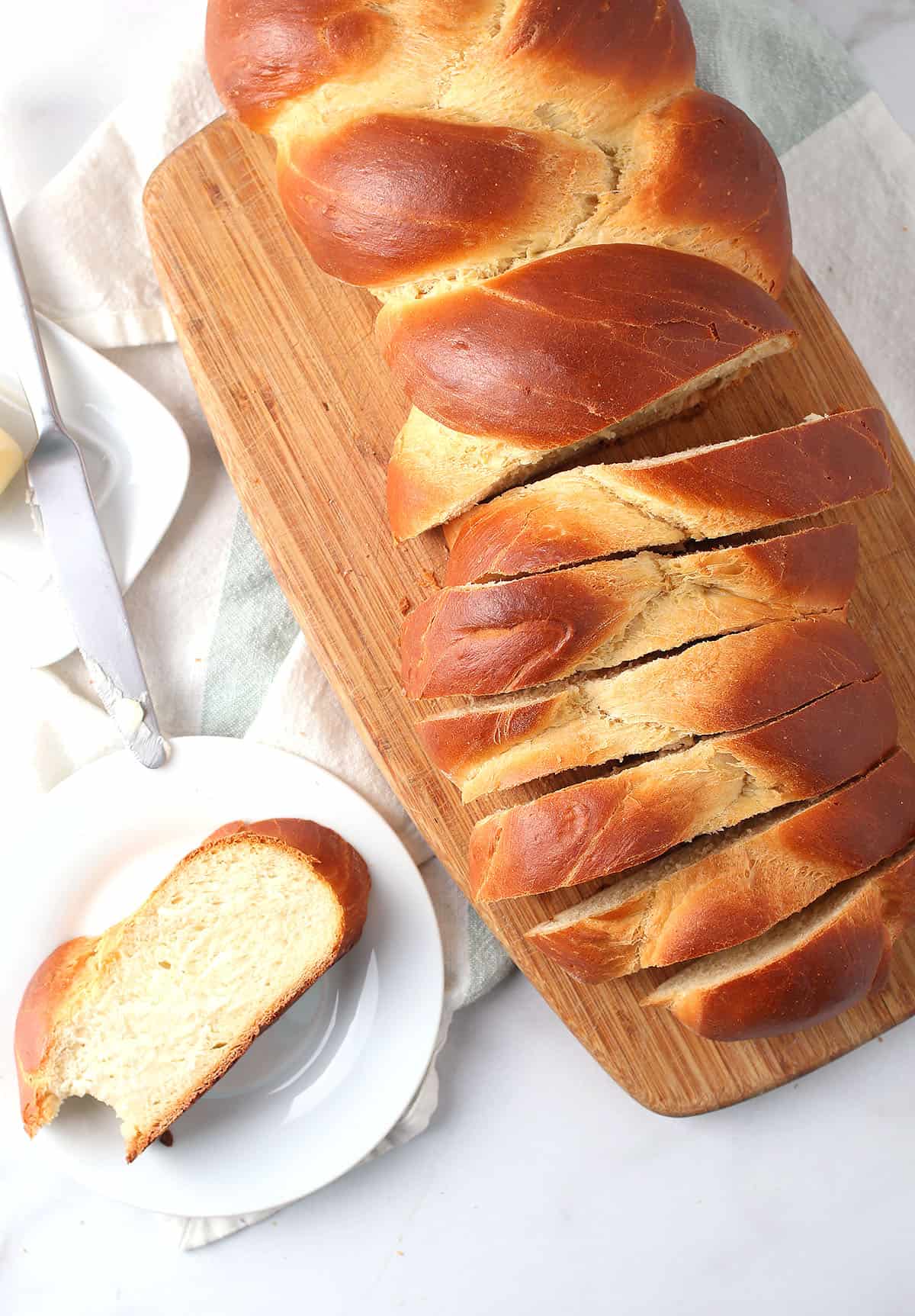
Disclosure: This post may contain affiliate links.
Years ago, I was a bread baker at a trending cafe and restaurant in Michigan. Sadly, the restaurant is now closed, but in the years that I baked bread for that wonderful place, I learned valuable lessons that I will take with me for the rest of my life.
One of the most popular breads we baked was our homemade challah. We used it for everything! It was the base of our french toast, the bread of many of our sandwiches, and pastry of choice for bread pudding.
Later, I moved onto other bakeries and continued making and perfecting challah. However, it wasn't until I quit working for other people and started working for myself that I started experimenting with vegan challah.
This recipe was one of the first recipes I created for this website, way back in 2012. Since then it has been made many times by my readers (that's, you!).
The recipe has been well loved and for that reason, I decided it was time to give it a little makeover.
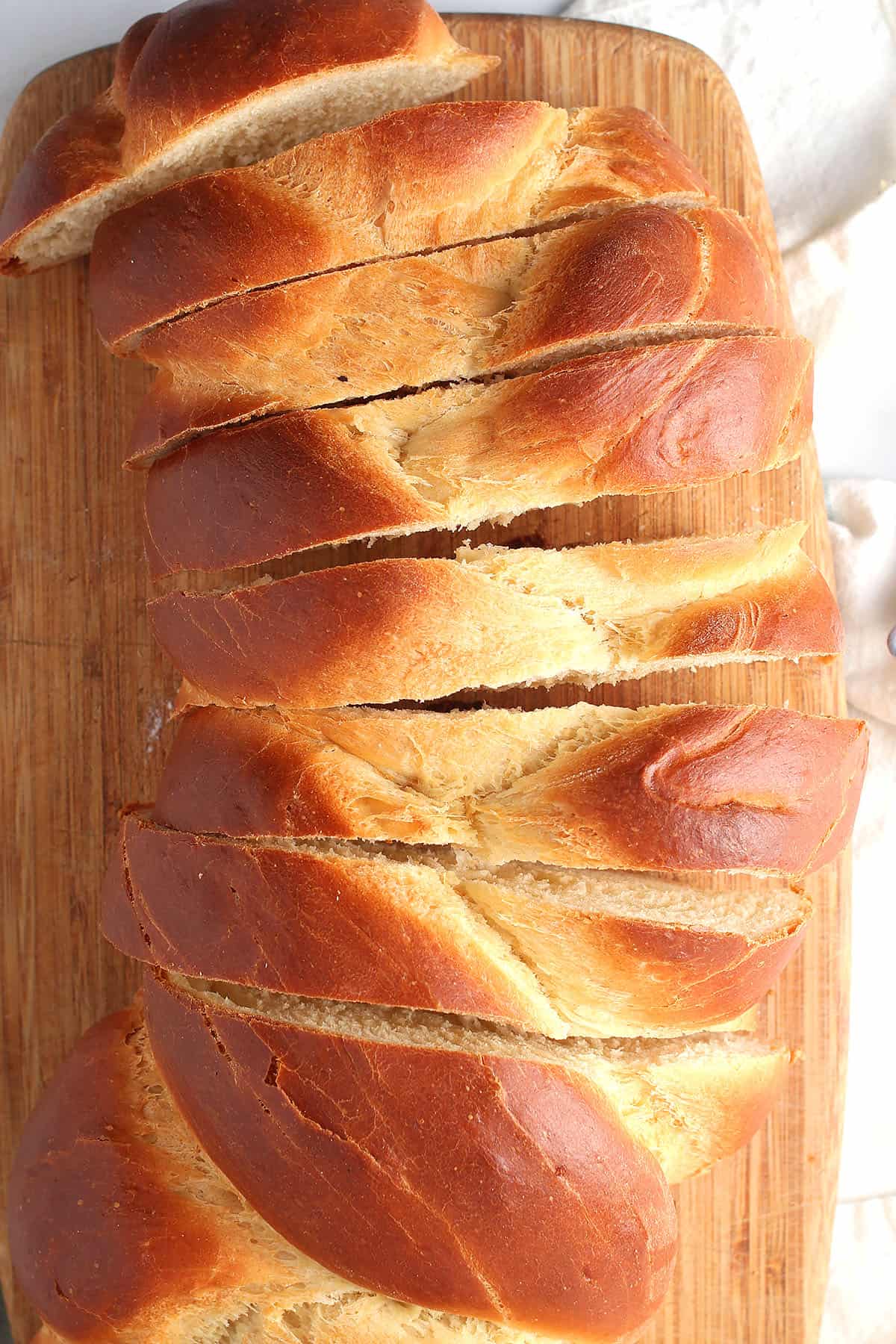
Ingredients & Substitutions
Challah is a soft, slightly sweet, enriched bread. The bread relies heavily on eggs and fat to give it that decadent texture. It took me several years to perfect this recipe and, friends, I think you're going to love it!
Here is everything you need.
- Active Dry Yeast - You can also use instant yeast if that's what you have on hand. The two are interchangeable in function. The only difference is that active dry yeast needs to be dissolved in a liquid to activate whereas instant yeast can be mixed right into the dough.
- Granulated Sugar - Check out my guide to vegan sugars.
- Chickpea Flour - This is used as the egg replacement. I love the chickpea flour eggs because they have a serious binding and leavening powder, similar to that of eggs which gives the bread its structure and lightness. Chickpea eggs are also completely flavorless meaning it won’t affect the taste of the bread itself. This is the only egg replacer that I recommend.
- Olive Oil - Most often I use olive oil but this recipe is also great with melted vegan butter.
- Salt
- All-Purpose Flour - I've had several people ask me if they can make this recipe gluten-free. I haven't yet tried using gluten-free flour, so I can't recommend it. If you've tried this recipe with a gluten-free flour blend, let us know how it turned out for you in the comment section below.
Step-by-Step Instructions
Step One - Make the Dough
Enriched yeasted dough often sounds far more intimidating than it is. While it takes time, the process is quite simple.
To start, place the yeast, 2 teaspoons of sugar, and warm water in the bottom of your bowl. Set aside for 10 minutes to allow the yeast to activate.
Pro Tip: It is very important that your water is warm but isn’t above 120F. Too hot and it will kill the yeast, making it unable to activate.
Slowly add the oil and chickpea egg, whisking while adding. Add the remaining sugar and salt. While mixing, gradually add the flour until dough begins to come together, but is still soft. This will be between 3-4 cups of flour depending on your altitude. The dough should be soft but not sticky.
Mix your dough for about 5 minutes in the stand-up mixer until it is well kneaded. Flip it out onto a floured surface and roll it into a ball. Place the dough in an oiled bowl, cover, and place in a warm area to let rise.
Step Two - Shape the Dough
After about 60 minutes, the dough should have doubled in size. Punch the dough down to release the air. Cover it and let it rise for an additional 30 minutes.
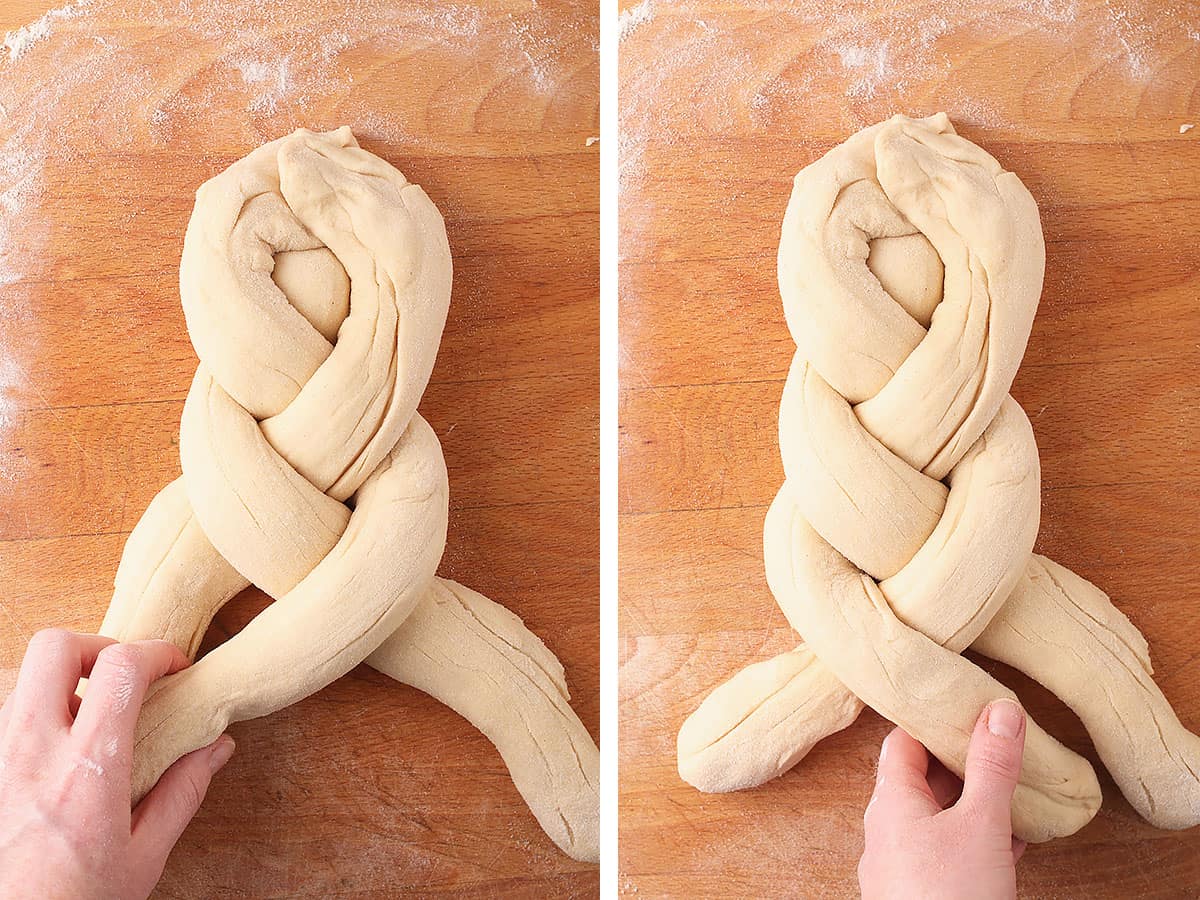
Flip the dough on a floured surface and cut into three equal pieces. A baking scale is the best way to ensure the pieces are even. Roll each piece into long strands (about 18 inches) and let sit for 5 minutes.
Once the dough has rested, braid it together, tucking in the ends underneath the loaf. Here is a good video tutorial.
Cover and let rest the dough rest for an additional 30 minutes.
Step Three - Bake the Bread
Preheat the oven to 375 degrees F. Brush loaf with soy milk one final time and bake 30-35 minutes, until the top is golden brown and a firm crust has formed.
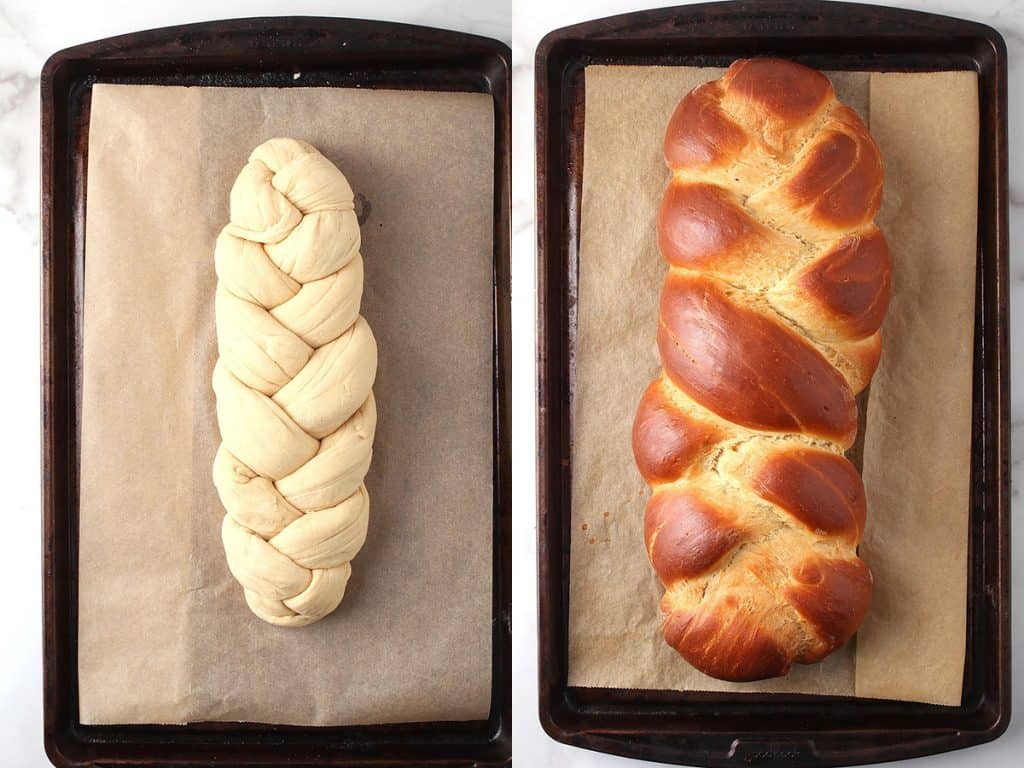
Remove from the oven and let it cool 10 minutes on a baking sheet before transferring it to a wire cooling rack to cool completely.
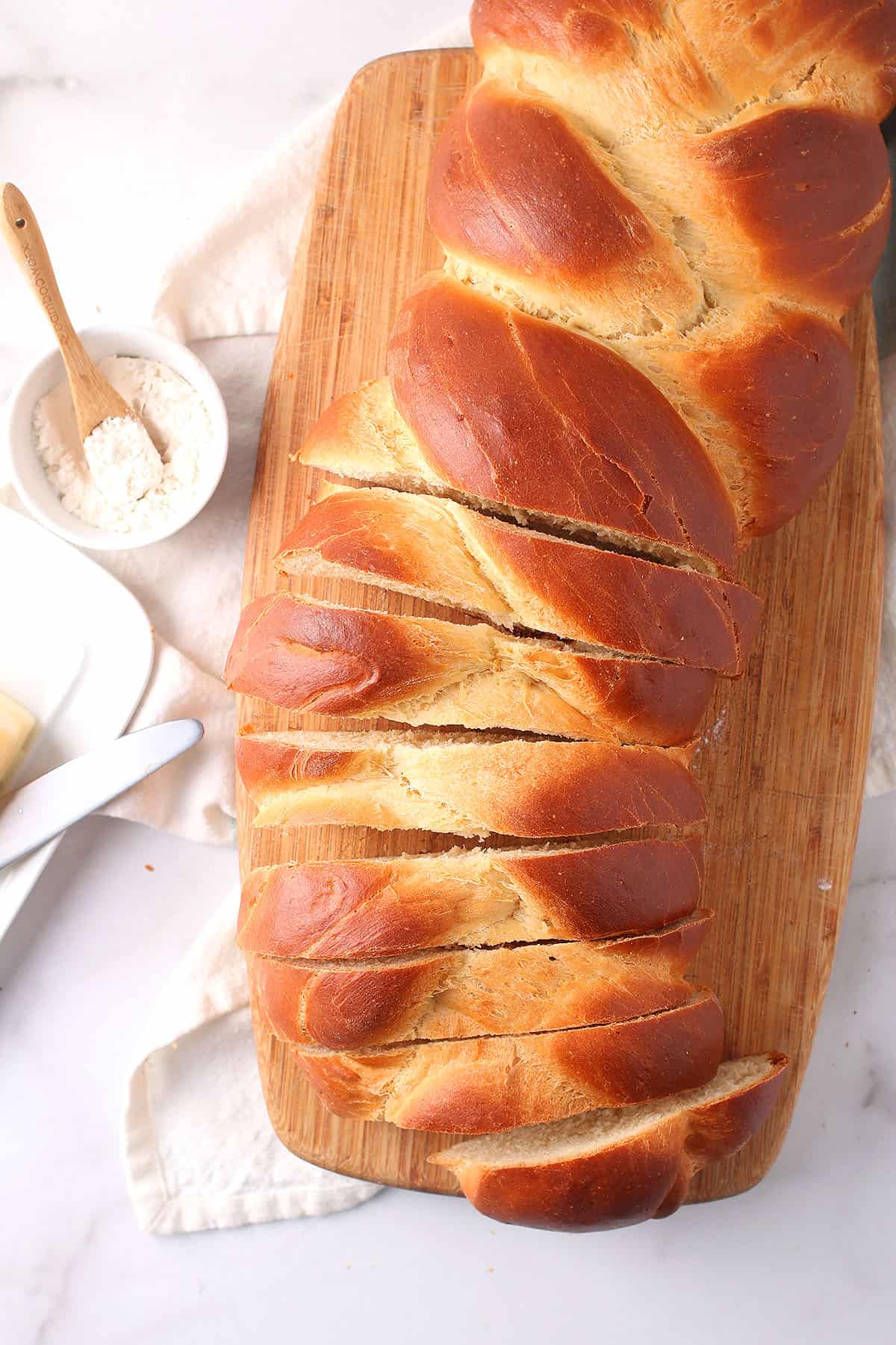
Serving and Storing
Serving - Serve this bread as a snack or part of a complete meal. Homemade Challah is perfect for French Toast or for sandwiches such as these Portobello Sandwiches with Caramelized Onions.
Storing - Store this bread in a plastic bag at room temperature for up to 5 days or in the freezer for up to 2 months.
Tips and Tricks
- Activate your yeast properly. To do this, make sure your yeast is not expired and the water is warm but not too hot. Otherwise, the yeast will not activate and you will not get a pillowy rise on the bread.
- Add flour slowly. The dough should be soft but not so sticky that you can’t handle it. This recipe calls for 3-4 cups of flour. Add it ½ cup at a time until you’ve achieved the desired dough.
- Let the dough rise in a warm place for 1 ½ – 2 hours, until the dough has doubled in size.
- Don’t skip the 2nd rise. Let your dough rise for an additional 30 minutes for a soft, melt-in-your-mouth texture.
Frequently Asked Questions
Unfortunately no. Chickpea flour is uniquely high in protein giving it binding and leavening powers that all-purpose flour simply cannot. You can find chickpea flour in most well-stocked grocery stores in the gluten-free aisle or you can pick some up online.
Yes, it can! If you want to make this sweet bread the night before, prepare the bread following the instructions below to the point of the 2nd rise. Once the bread is shaped, cover it with plastic wrap and place it in the refrigerator overnight. The next morning, remove the dough from the refrigerator 30 minutes prior to baking.
No! While a stand-up mixer makes this recipe much easier, you can certainly make this bread by hand. Simply combine the ingredients in a large mixing bowl and knead it together on a floured surface. Knead the dough for 10 minutes before the first rise.
I actually haven't tried this and so I can't recommend this but I am asked this question fairly frequently. If you've tried this recipe with a gluten-free flour blend, let us know how it turned out for you in the comment section below.
More Vegan Bread Recipes
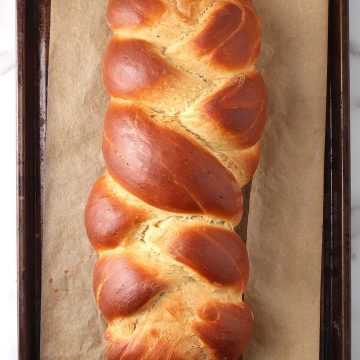
Vegan Challah
Ingredients
- 2 ½ teaspoon active dry yeast
- ¼ cup + 2 tsp sugar
- 1 cup water
- ½ cup chickpea flour + ½ cup water
- ¼ cup olive oil
- 1 ½ teaspoon salt
- 3-4 cups all-purpose flour
Instructions
- In a stand-up mixer, with the dough hook attachment, whisk together yeast, 2 teaspoons sugar, and 1 cup lukewarm. Set aside for 5 minutes to allow the yeast to activate and sugar to dissolve.
- In a food processor or blender, blend together the chickpea flour along with ½ cup water until it is thick and foamy. This is your chickpea egg. Set aside.
- With the motor running, slowly add the oil and chickpea egg into the yeast mixture. Add the remaining ¼ cup of sugar and salt. Whisk together. Gradually add the flour, one cup at a time, until the dough begins to come together. Turn the speed to medium-high and knead for 5 minutes until dough begins clearing the sides and forms a smooth ball. You want the dough to feel soft, but not sticky.
- Remove the dough and place it in an oiled bowl. Cover and let rise in a warm place for one hour, until doubled in size. Punch the dough down to remove any air bubbles, re-cover, and let rise an additional 30 minutes.
- Turn the dough on a floured surface and cut into three equal pieces. Roll each piece into long strands (about 18 inches) and let sit for 5 minutes. Now, braid the challah. Here is a good video tutorial.
- Brush the loaf with soy milk and set aside to rise for 30 more minutes, until dough slowly pushes back when an indentation is created with your finger.
- Preheat the oven to 375 degrees F. Brush loaf with soy milk on final time and bake 30-35 minutes, until the top is golden brown and a firm crust has formed.
- Let cool completely before slicing.
Notes
- Activate your yeast properly. To do this, make sure your yeast is not expired and the water is warm but not too hot. Otherwise, the yeast will not activate and you will not get a pillowy rise on the bread.
- Add flour slowly. The dough should be soft but not so sticky that you can’t handle it. This recipe calls for 3-4 cups of flour. Add it ½ cup at a time until you’ve achieved the desired dough.
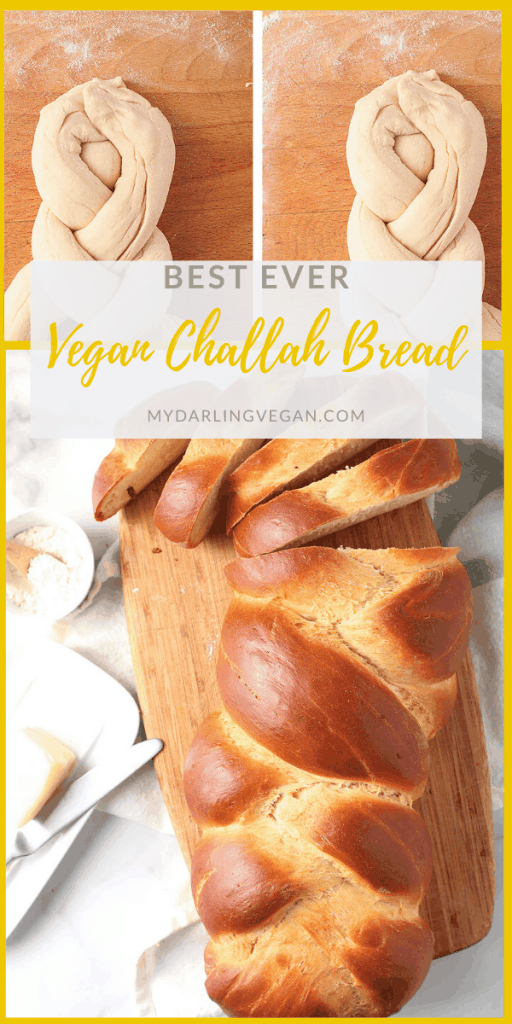
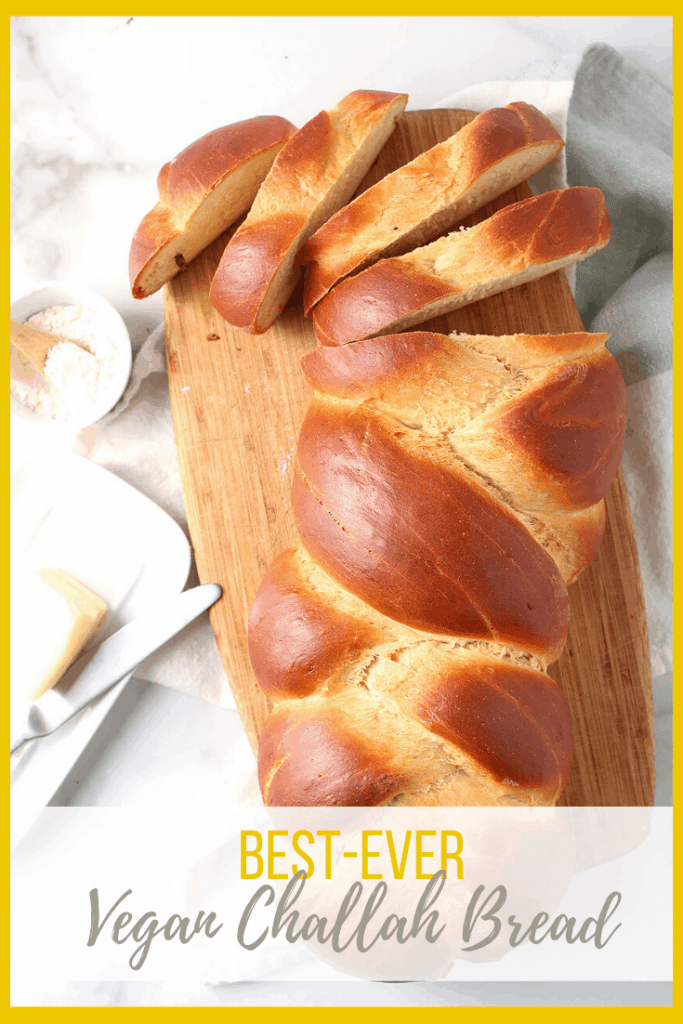
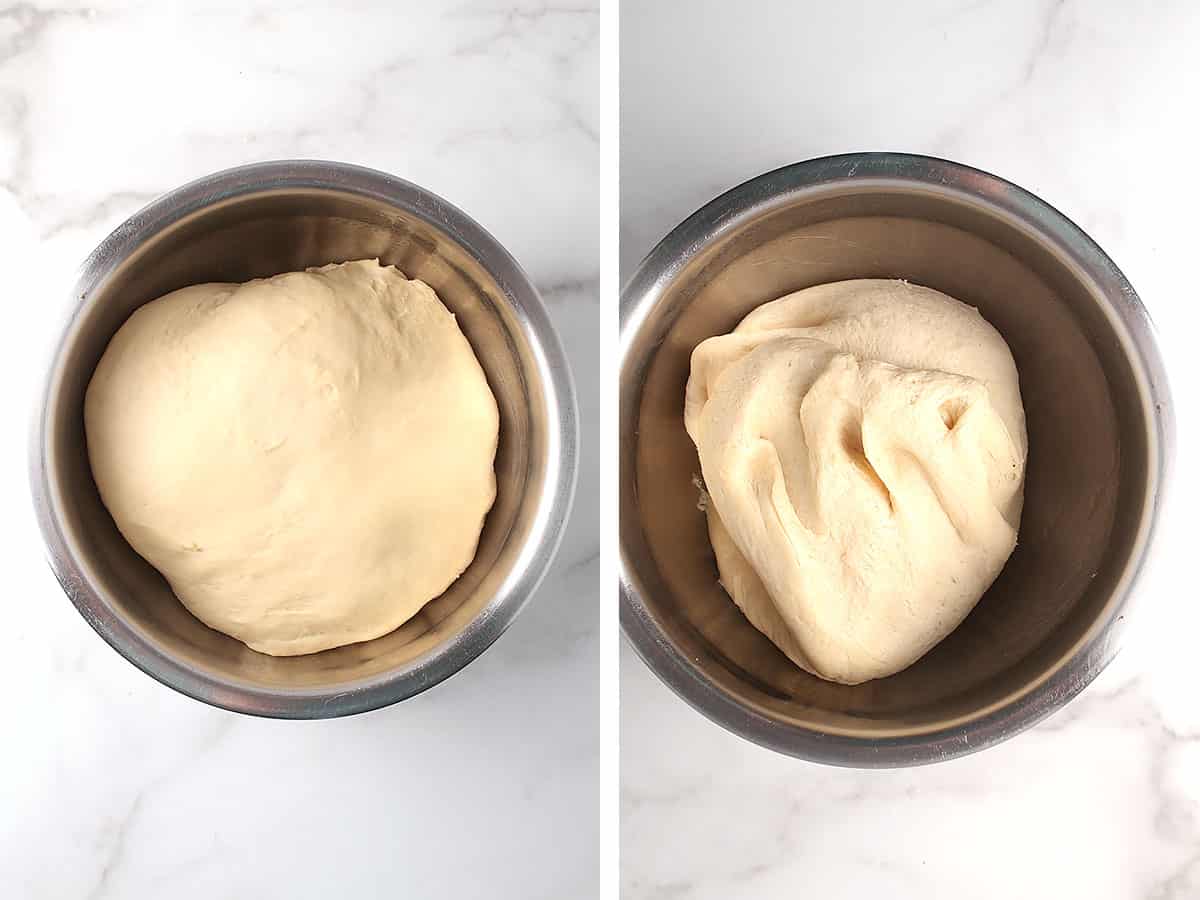
 Hi, I’m Sarah. I’m a 14-year (and counting) vegan, professionally trained photographer, former pastry chef, founder of My Darling Vegan, and author of the
Hi, I’m Sarah. I’m a 14-year (and counting) vegan, professionally trained photographer, former pastry chef, founder of My Darling Vegan, and author of the
stephanie says
This. Was. Amazing.
It smelled and tasted so much like egg-challah that my little shabbat group did not believe it was vegan.
Also, it brought all the GF-girls to the yard. This challah was womped on while the GF one was left sadly neglected in the corner.
You gave challah back to me. Thank you, thank you, thank you.
Sarah says
Thank you for your kind words. You made my day.
Amanda says
Update to my previous comment... I used coconut flour, in place of the chickpea flour, in the Challah that I made last night, for Rosh Hashana dinner.... HOLY MACARONI!!! Since coconut flour is known to hold moisture, it made the challah SO fluffy!! With a soft sweetness, it was a hit! Making the same thing, today, and adding chocolate chips. Mmmm!!! I really love this recipe!
Amanda says
I made Challah, using this recipe, last week for our family Shabbat dinner. I did two things differently... For the brushed on glaze, I mixed maple syrup and non-dairy milk, then brushed the loaf with that mixture. Then I sprinkled Hemp Heart hemp seeds on top of the loaf, instead of poppyseeds. My husband who was raised Jewish (I wasn't) said it was "the best Challah" he's ever tasted! I was ecstatic! Now I'm making it for Rosh Hashana dinner, for tonight!! Thank you for a WONDERFUL veganized Challah recipe!
Rebecca says
I made the challah on Friday and used the leftovers to make your vegan french toast recipe for breakfast on Saturday, and they were both delicious. Thank you!
Amy says
Any suggestions for something else to brush the top with other than soy milk? We've got egg and soy allergies here. Perhaps rice or coconut milk?
Sarah says
Coconut milk would be a great alternative!
Becky says
What a wonderful recipe! Thank you so much. We have very close friends who are vegan and I'm always trying to come up with fun conversions. This year it was a vegan king cake. I basically filled tubes of this bread dough with vegan king cake filling and braided them. It came out beautifully. The extra dough I rolled out and spread with the filling, cut into strips and made "knots". My friend and her husband couldn't say enough about the bread recipe, in fact I think it came out better than the non-vegan king cake I made for my husbands work! Thanks again!
Sarah says
Wow! Sounds amazing! Thanks for sharing.
Julia says
Thank you for this recipe! I had tried modifying other non-vegan recipes but they came out dense and cracked. Your recipe comes out light, fluffy, and beautiful every time. I also loved the link to the "how to brain challah." My new favorite is the 4-stranded braid. Gorgeous.
Thanks again, and happy holidays!
glycosidic says
I have been experimenting with making challah and Zopf (a possibly related Swiss braided bread, but more reliant on dairy than eggs) - in particular, one of the things I am hoping to achieve is that shiny, dark golden rust associated with egg yolk glaze, without using eggs. I shall have to try soy milk like you did here - thanks for the tip! I presume you used sweetened soy milk (as I would think that sugar would aid with caramelisation)?
Sarah says
Sweetened soy milk is the best as well as enriched soy milk which has extra protein because the protein will help with the desired crust effect as well.
Julie T. says
I made this yesterday, it was SO good. The chickpea flour is genius, it gave it just the right texture! I had to pick up my kids, so I was about an hour over on the second rise, but it still turned out great. Thank you for posting this!
Sarah says
I'm glad you tried it Julie. Chickpea flour is quite amazing as an egg replacer.
Zoe says
Hiya! I absolutely adore your site 🙂 Just wondering, is it okay if the bread isn't golden-brown? Just want to make sure it doesn't ruin the recipe completely. I just made a loaf (have not tried yet).
Thanks!
Sarah says
Yeah, it will be fine. I hope you like the recipe!
Jessie says
This is such a wonderful recipe. So exactly Challah-y! Thank you!
Jen says
Thanks!
Jen says
Have you tried adding other ingredients or flavors? I was looking for a recipe to make a vegan version of my family's Italian egg bread for Easter, which is flavored with orange peel and anise, and also includes chopped almonds. Do you think this recipe would hold up? It otherwise looks wonderfully simple, actually easier than the egg/dairy version. 🙂
Sarah says
It would hold up as long as you didn't add too many heavy ingredients. Orange peel and anise should be fine and I think chopped almonds would work if you added a small amount. Let me know how it turns out!
Nancy says
Any advice making this but using a bread machine for kneading and the first rise before shaping? We use the instant yeast (" bread machine yeast").
Sarah says
I think that would work fine. As long as you take it out right after the first rise I don't see why there would be any problem. Let me know how it turns out!
Sheri says
what can I use instead of chickpea flour, I have all other kinds, brown rice, quinoa, whole wheat. would any of these work?
Sarah says
I have had no experiences using these other flours as egg replacers, but your best bet would be quinoa flour. The chickpea flour works well because the high protein content of the flour replaces the eggs as a binder. Since quinoa flour is also high in protein, I am GUESSING it would work too.
Or if you have commercial egg replacer, you could use that in replace of the chickpea flour.
Good luck. If you go for it, let me know how it turns out!
Helen says
Here in the UK it is difficult to find chickpea flour but Gram Flour ( yellow split pea flour) is easy to find and that is very high in protein.
Also very high in protein is Teff flour, less easy to find but packed with nutrients with a nutty taste.
Both of these flours are naturally gluten free, could I use these instead of the Chick pea flour please?
malloreigh says
I want to make this less sweet - can I reduce the sugar without losing texture?
Sarah says
sugar creates tenderness and therefore the texture will be slightly tougher, but hardly noticeable. If you cut just a little of the flour as well and keep the dough softer, it should balance it out. Getting the dough to the right consistency before baking is really the key to great texture.You want it to kind of feel like a marshmallow after it's kneaded, before it's first rise. (much softer than other breads)
As it is it doesn't taste like a sweet bread, there is just a sweet aftertaste.
Hope this helps!